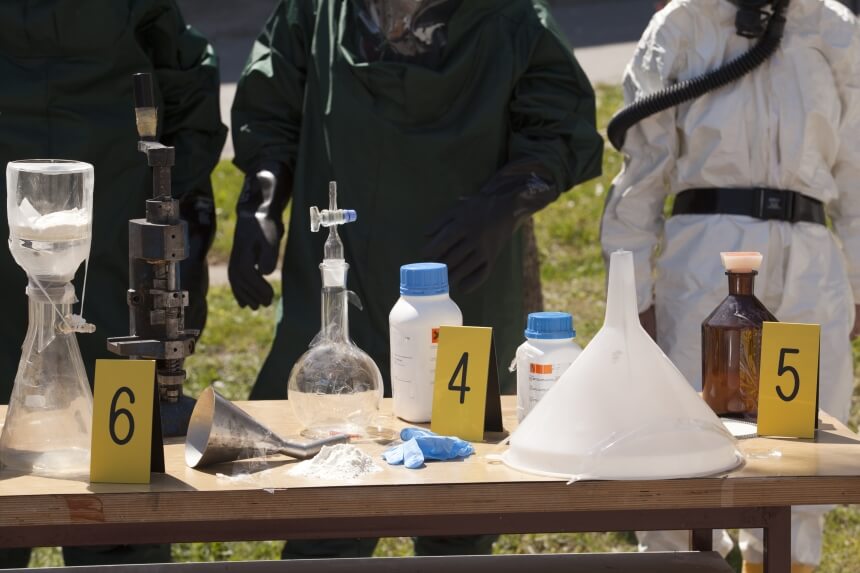
As the use of drugs and incidences of crime in the workplace rise, employers must be vigilant. Companies may think they are safe if they have a strict drug policy in place. However, sometimes it is the legitimate workplace chemicals used to make drugs that can cause the most harm.
The Plastics and Chemicals Industries Association in Australia is supporting law enforcement in their crack down on the use of legitimate chemicals in the making of illegal substances. Some of the most widely used industrial chemicals are now included in the Code of Practice for Supply Diversion into Illicit Drug Manufacture.[1]
A workplace can be filled with legitimate chemicals that can be diverted to illegal use. Here are a few of the top industrial chemicals that have been used in illegal drug production.
Phosphorus
Phosphorus is an industrial chemical compound that is found in fertilizers, detergents, pesticides, and even matches. It is also used in the making of methamphetamine.
Nitroethane
Nitroethane is a common chemical solvent and fuel additive. This industrial chemical has no colour and a fruit-like smell. It can be used methamphetamine production.
Formamide
Formamide is a chemical used in the making of certain prescription drugs. It can show up in the workplace as a softener for materials such as fiber and paper. In addition, it is used as a solvent. This industrial chemical can be utilized to make MDMA or Ecstasy.
Ammonia
Ammonia is used in numerous companies and homes as a cleaning agent. The chemical ammonia is a colorless gas and has a strong odor. It is widely used in fertilizers. Anhydrous ammonia is used in meth production and can be used by people who freebase cocaine and crack.
Diethylamine
Diethylamine is an alkaline liquid that is very flammable. It has no color but has a strong odor. It is most commonly used in the production of resins and rubber. It can also be used in making dyes. Employers may be more familiar with the common name of this chemical – lysergic acid – or a form of LSD.
Magnesium
Magnesium is a common industrial chemical found in fertilizers. It is sometimes used to treat depression. However, it can be used illegally. Magnesium sulfate is marketed as ‘bath salts’ and is quickly becoming the biggest new designer drug. The fact that this chemical can be inhaled, snorted, injected, or smoked in the bath salt form makes it easy prey to drug abusers in the workplace.
Potassium Dichromate
Potassium dichromate is a widespread industrial chemical. It is bright red or orange in colour. This chemical is used for cleaning solutions, in the making of cement, and in photography among other things. It is extremely dangerous to handle and can cause severe burns. Potassium dichromate is a central ingredient in the processing of cocoa leaves into cocaine and in making of other illegal drugs.
Hydrochloric Acid
Hydrochloric acid is another commonly used industrial chemical. It is a corrosive chemical that is used in cleaning, gelatin production, and leather processing. Hydrochloric acid is used in methamphetamine production.
These are only a few of the legitimate workplace industrial chemicals used to make illegal drugs. Employers should know what chemicals are used within their company and monitor them at all times.
The National Occupational Health and Safety Commission has created standards for industrial chemicals and their use and safety in the workplace. Many chemicals are now being categorized as Schedule 1 and Schedule 2.[2] This will allow the government to aid employers in monitoring their use.
Employers need to institute procedures to closely monitor workplace chemicals to ensure they are not used for illegal drug making. In addition, it’s important to test employees on a random basis to verify workers are drug and alcohol free. Our sister company Mediscreen™offers drug and alcohol screening services on a 24/7 basis so that all shifts can be covered.
References
[1] Plastics and Chemicals Industries Association. (n.d.). Retrieved from PACIA: www.pacia.org.au/DownFile.Aspx?fileid=191
[2] Existing Chemicals Information Sheet. (n.d.). Retrieved from NICNAS: http://www.nicnas.gov.au/publications/information_sheets/general_information_sheets/ecis_chemicals_banned_restricted_pdf.pdf
Categories
Archive
- February 2022
- October 2021
- June 2021
- November 2020
- October 2020
- June 2020
- March 2020
- February 2018
- December 2017
- August 2017
- February 2017
- September 2016
- August 2016
- October 2013
- September 2013
- July 2013
- May 2013
- February 2013
- December 2012
- November 2012
- August 2012
- June 2012
- February 2012
- December 2011
- October 2010
